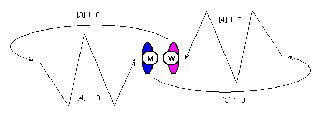The dancers then dance the following pattern together:

|
|
|
|
|
There are a number of versions of this dance presented in Il Ballarino and Nobilta. This is probably the simplest and most elegant of the versions, from Il Ballarino. This reconstruction is from The Letter of Dance, issue 6. The dance differs from a lot of other dances of the period, in that it starts on the right foot instead of the left. The dance stays in duple time througout. |
|
|
|
|
Introduction |
The dance starts with one man in the center of the floor, holding a flower in his right hand. |
|
|
|
|
|
1 - 4 |
Rv R |
Begin the dance with a riverenza on the right foot. |
|
|
5 - 8 |
SgR, SgL |
Two seguiti, turning in place. |
|
|
|
|
Figure 1 This part is done moving towards a lady. When he reaches her, he does the continenze and the riverenza. |
1 - 8 |
Sg R, L, R, L |
Four seguiti. |
|
9 - 12 |
CnR CnL |
Two continenze R & L, moving sideways. |
|
|
13 - 16 |
Rv R |
As he does the riverenza, the lady stands, and he takes her left hand in his right hand, passing the flower into his left hand. |
|
|
|
|
Figure 2 |
1 - 4 |
Sg R, L |
Two doubles. |
|
|
5 - 8 |
Sc R, R |
Two scorsi doubles, 8 steps each, moving out onto the floor |
|
|
9 - 12 |
CnR CnL |
Two slow singles R & L, moving sideways. |
|
|
13 - 16 |
Rv R |
Riverenza |
|
|
|
|
The dancers then dance the following pattern together: |
|
|
|
|
|
Figure 3 |
1 - 8 |
Sg R, L, R, L |
Four seguiti, moving in a J figure. |
|
|
9 - 12 |
CnR CnL |
Two slow singles R & L, moving sideways. |
|
|
13 - 16 |
Rv R |
Riverenza |
|
|
|
|
Figure 4 |
1 - 8 |
Sg R, L, R, L |
Four seguiti, moving in a flanking figure. |
|
|
9 - 12 |
CnR CnL |
Two slow singles R & L, moving sideways. |
|
|
13 - 16 |
Rv R |
Riverenza |
|
|
|
|
|
During the last riverenza, the gentleman kisses the flower, and at the end of the riverenza he passes it to the lady, who takes it in her left hand. |
|
|
|
|
Repeats |
The dance then repeats from the start, with the lady dancing to find a new partner, and the man either dances off the floor, or finds a new partner himself. An alternative is that the man starts the dance in the center of the floor, holding a bunch of flowers. At the end of the first repeat of the dance he would then pass half of the bunch to the lady. They would then both seek new partners, and the bunch would continue to be divided in half until each dancer had their own flower. This dance and the music was fairly obviously used by Arbeau as the basis for his “Torch Bransle”. |
|
|
|